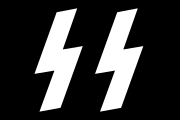II SS Panzer Corps
| II SS Panzer Corps | |
|---|---|
| Active | July 1942 – 8 May 1945 |
| Country |
|
| Allegiance | Adolf Hitler |
| Branch |
|
| Type | Panzer corps |
| Role | Armoured warfare |
| Size | Corps |
| Engagements | World War II |
The II SS Panzer Corps was a German Waffen-SS armoured corps which saw action on both the Eastern and Western Fronts during World War II. It was commanded by Paul Hausser during the Third Battle of Kharkov and the Battle of Kursk in 1943 and by Wilhelm Bittrich on the Western Front in 1944.
World War II
1943
The II SS Panzer Corps was formed from SS Division Das Reich and SS Division Hohenstaufen in July 1942. In early February 1943, the corps, under the command of SS-Gruppenführer Paul Hausser, was attached to Army Group South in Ukraine and participated in the Third Battle of Kharkov.
The corps was renamed II SS Panzer Corps in June 1943, after the I SS Panzer Corps was created during that same month. In July 1943, the corps took part in the failed Operation Citadel, spearheading 4th Panzer Army's attack in the southern sector. The corps' three SS divisions were involved in the Battle of Prokhorovka at the edge of the German penetration into the salient. After the operation was canceled in light of its failure, the corps was ordered to the Italian front. Only one division, the Leibstandarte SS Adolf Hitler ended up being transferred, along with the corps personnel. The remaining combat divisions remained on the Eastern Front to deal with the developing threats from the Soviet Belgorod-Khar'kov Offensive Operation. Leibstandarte took part in operations to disarm Italian troops.
Between 20 September and 20 of November 1943 the corps conducted operations against Yugoslav Partisans in order to establish a connection with Army Group F in the Balkans and to secure communications east and northwards from Trieste and Rijeka. In these operations, according to the Corps Headquarters' Medical Department, the corps suffered total losses of 936 men.[1] According to Croat authors, in the first phase against partisans on Istrian peninsula (Unterhehmen Istrien), some 2000 partisans and 2000 civilians were killed by German forces, and additional 1200 were arrested, with some 400 transported to concentration camps.[2] In November, 1943, Leibstandarte returned to the Soviet Union, with the corps remaining in Slovenia, Istria and northern Italy. In January 1944, the corps was ordered to France to refit, before being sent back to the Eastern Front, where it took part in the efforts to relieve the encircled 1st Panzer Army.
1944–45
In June 1944, the corps was ordered west to take part in the Battle of Normandy. It was involved in heavy fighting against the British 21st Army Group in the Battle of Caen. During this period, SS-Obergruppenführer Wilhelm Bittrich was placed in command of the corps. In August 1944, the corps participated in the battles in and around the Falaise Pocket. The corps then retreated across France. On 17 September 1944, the Allies launched Operation Market Garden, an airborne offensive aimed at capturing the Rhine bridge at Arnhem. The corps was involved in fighting against the British 1st Airborne Division in the Battle of Arnhem and also against the U.S. 82nd Airborne Division and British XXX Corps in Nijmegen.
In preparation for the Ardennes Offensive, the corps was placed in reserve of 6th SS Panzer Army and committed on 21 December 1944 near St. Vith. After the northern assault stalled, the corps was transferred south to take part in the attack on Bastogne. The corps' divisions suffered heavy losses in the battles against the 82nd and 101st Airborne Divisions. After the operation's failure, the corps returned to the defensive, seeing action against American forces in the Eifel region.
In February 1945, the corps was ordered to Hungary to take part in an offensive to recapture Budapest and the Hungarian oilfields. The corps took part in Operation Spring Awakening, launched near Lake Balaton on 6 March 1945. After the failure of the offensive, the corps retreated, alongside the I SS and IV SS Panzer Corps, towards Vienna. After the Soviet forces captured the city, individual units attempted to break out to the west. The elements of the corps surrendered to the U.S. Army on 8 May 1945.
Commanders
- SS-Obergruppenführer Paul Hausser (1 June 1942 - 28 June 1944)
- SS-Obergruppenführer Wilhelm Bittrich (10 July 1944 - 9 May 1945)
Order of battle
July 1943 – Operation Citadel
- SS Division Leibstandarte
- SS Division Das Reich
- SS Division Totenkopf
- Elements of 167.Infanterie-Division
September 1943[3]
- SS Division Leibstandarte
- 24th Panzer Division
- 44th Infantry Division Hoch und Deutschmeister
- 71st Infantry Division
- 162nd Turkoman Division
October 1943[4]
September 1944 - Operation Market Garden
March 1945 - Operation Frühlingserwachen
- Schwere SS-Panzer-Abteilung 502
- 9.SS-Panzer-Division Hohenstaufen
- 2.SS-Panzer-Division Das Reich
- (44.) Reichsgrenadier-Division Hoch- und Deutschmeister
- 23.Panzer-Division
References
Sources
- German Documents, Publication T354, roll 606: II. SS Panzerkorps, June-December 1943. Washington: National archive. Archived from the original on April 20, 2013.
Further reading
- Reynolds, Michael - Sons of the Reich: The History of II SS Panzer Corps
